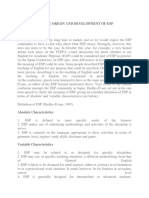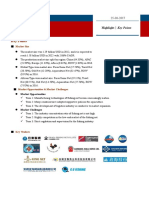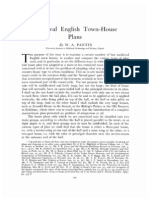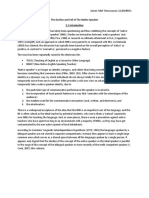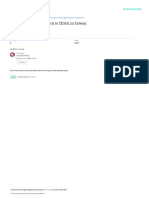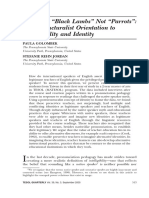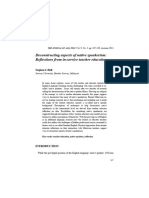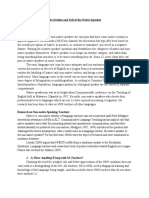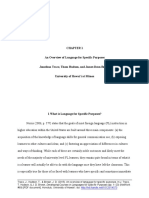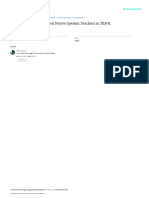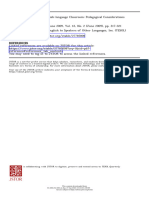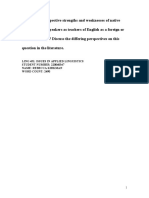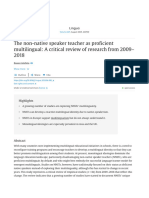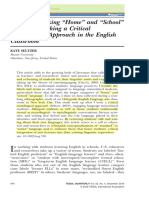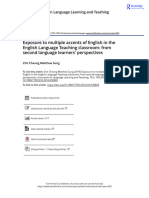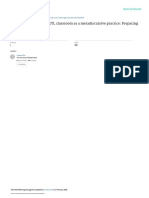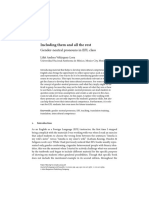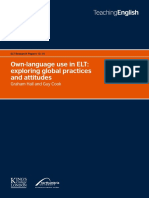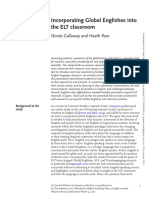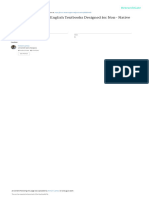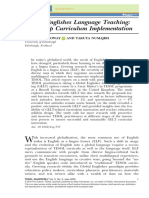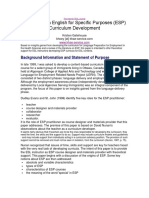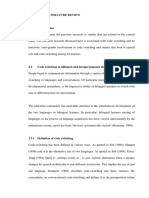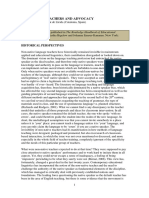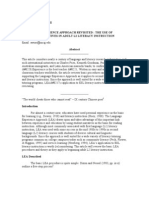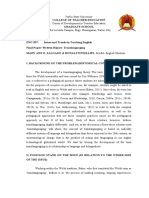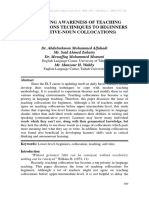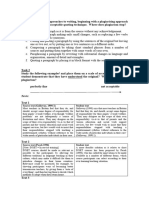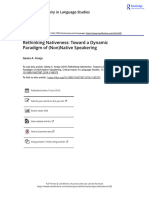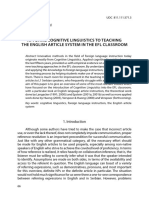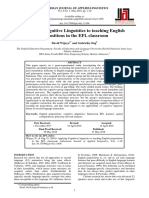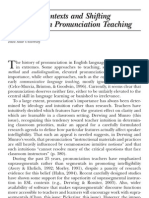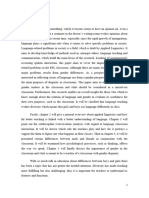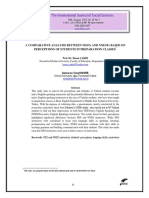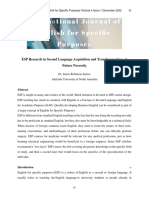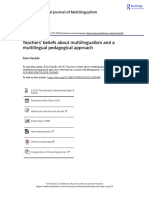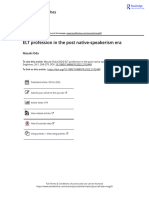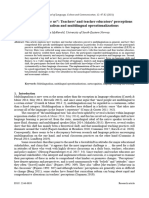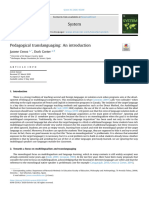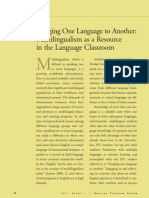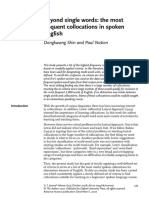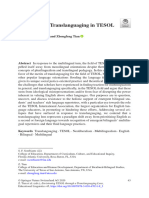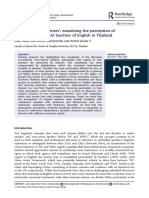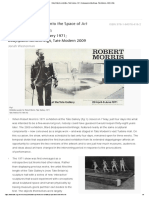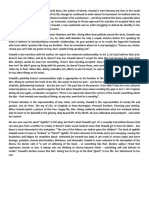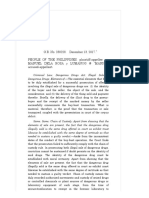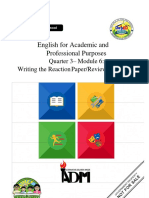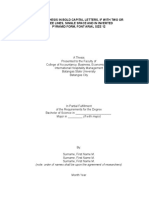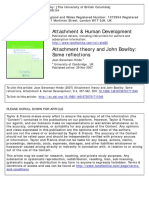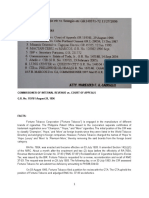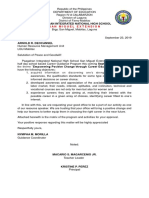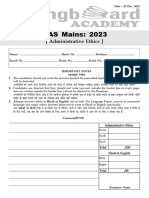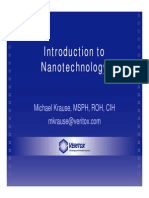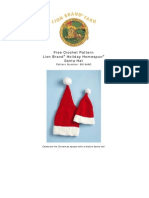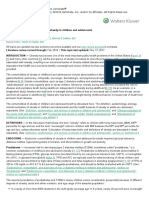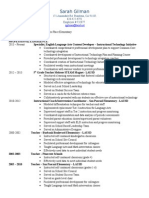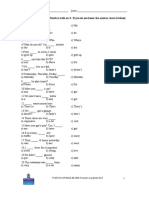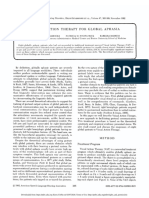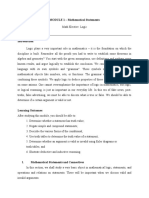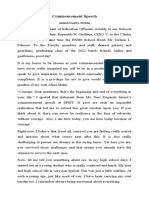Alternative Terms For NNESTs
Alternative Terms For NNESTs
Uploaded by
DaveOriginal Title
Copyright
Available Formats
Share this document
Did you find this document useful?
Is this content inappropriate?
Report this DocumentCopyright:
Available Formats
Alternative Terms For NNESTs
Alternative Terms For NNESTs
Uploaded by
DaveCopyright:
Available Formats
Alternative Terms for NNESTs
RASHI JAIN
Framing the Issue
The terms non-native English speakers (NNESs) and non-native English-speaking
teachers (NNESTs) are widely used in many English-language settings around the
world. These terms are also frequently seen in literature about learners and teach-
ers of English who speak English as a second, foreign, international, or an addi-
tional language. Some of the earliest instances of the use of the term “non-native
English speaker” in published educational literature—including books, journals,
and conference proceedings—date back to as early as the 1960s and 1970s. In
TESOL, the term NNEST has gained currency over the last half-century, culminat-
ing in the NNEST movement that began to emerge in the mid-1990s in the work of
self-identified NNES scholars within the field (see Braine, 2010; Mahboob, 2010)
and has also been enriched by contributions from NES scholars over the years.
The issue of establishing native and non-native English speaker identities has
long been a problematic one. Chomsky (1965, p. 3) has defined a native speaker as
an “ideal speaker-listener, in a completely homogeneous speech community, who
knows its language perfectly.” Such a definition assumes that a native speaker is
“perfectly” proficient in his or her language. Other researchers have questioned
the validity of such a definition. Other attempts to identify a native speaker by
virtue of such biographical information as country of birth or childhood are also
attended by problems.
Adding to this complexity of categorizing English speakers as “native” or “non-
native” is the reality that according to recent estimates, those who teach English-
language learners are increasingly themselves speakers of more than one language.
Often identified singularly as non-native English-speaking teachers (NNESTs),
these teachers in reality represent a diversity of (English) language-learning and
acquisition experiences. Additionally, the seemingly neutral label of NNEST per-
petuates an artificial dichotomy between those who speak English “natively” and
those who do not, which then gets transferred to ideas about who is a legitimate
English teacher and who is not. This fallacy of the native (English) speaker as the
“ideal” (English) teacher has done much disservice to all participants in TESOL,
The TESOL Encyclopedia of English Language Teaching, First Edition.
Edited by John I. Liontas (Project Editor: Margo DelliCarpini).
© 2018 John Wiley & Sons, Inc. Published 2018 by John Wiley & Sons, Inc.
DOI: 10.1002/9781118784235.eelt0005
v2b_lbp-A.indd 1 10/31/2017 2:53:17 PM
2 Alternative Terms for NNESTs
teachers and students alike. There exists, as a result, a consistent critique of the
terms NNES and NNEST.
While some continue to use the terms—NES(T) and NNES(T)—to perpetuate
the perceived dichotomy, others have taken ownership of the terms to chal-
lenge the underlying assumptions (see Braine, 2010; Mahboob, 2010). These
efforts have resulted in the well-recognized NNEST movement that aims to
highlight issues surrounding NNESTs in TESOL. Scholars in the field also
continue to use the terms NNES and NNEST to problematize stereotypes,
myths, and discriminatory practices perpetuated through the implicit or
explicit use of the labels.
Additionally, alternative terms have been offered in literature for “NNES”
language users that are largely self-explanatory, including “proficient user of the
language,” “language expert,” “English-using speech fellowship,” “multicompe-
tent speaker,” and “intercultural speaker.” TESOL scholars have also proposed
alternative terms for NNESTs, such as: multicompetent teachers, bilingual or
multilingual teachers, and translingual teachers. This entry provides an overview
of some of these key alternative terms for NNESTs in TESOL.
Making the Case
As already mentioned, many alternatives have been suggested for NNES. While
some of these alternative terms have then been extended to NNESTs as well, other
entirely new terms have also been used specifically for NNESTs. Some of the key
terms that pertain to English-language teachers are explored briefly below.
Multicompetent Teachers
Cook (1999) defines multicompetence as the knowledge of two or more languages
in one mind. While Cook has not used the term specifically for language teachers,
others have extended the notion of “multicompetent” to (re)define and (re)imag-
ine NNESTs (e.g., Blair, 2012; Pavlenko, 2003). Pavlenko (2003), in particular, has
provided a powerful reconceptualization of the NNEST as a multicompetent
teacher. Her seminal studies paved the way for more work based on the notion of
multicompetence that opens up the possibility of imagined alternative communi-
ties for (second) language users and teachers to reposition themselves as multi-
competent, bilingual, and multilingual speakers.
Bilingual and Multilingual Teachers
Teachers who speak English as a second, an additional, or a “nativized” language
are sometimes described as bilingual or multilingual teachers in TESOL, as
opposed to “NNEST” (e.g., Blair, 2012). In reality, these terms can be expanded and
applied to all English teachers who are proficient in more than one language,
v2b_lbp-A.indd 2 10/31/2017 2:53:17 PM
Alternative Terms for NNESTs 3
regardless of whether they grew up in a monolingual English-only environment,
or with English as their primary language, or with English as one of the two or
more primary languages in operation (see Edge, 2010). However, the terms
bilingual and multilingual teachers, when applied to those traditionally identified
as NNESTs, serve the critical function of highlighting the diverse linguistic
resources that teachers can potentially bring into their classrooms. In that sense, by
not being subtractive and focusing not on what is “missing” (i.e., “native English”),
these terms are similar to the additive idea of the multicompetent teacher.
Translingual Teachers
One of the critiques of the terms bilingual and multilingual teachers is that these
terms stem from a monolingual orientation, and do not adequately capture the
linguistic dynamism that can be found in contexts where many languages operate
simultaneously (see Canagarajah, 2013; Pennycook, 2008). In response to this
criticism, scholars have proposed the ideas of translingualism and translinguistic
identities (e.g., Canagarajah, 2013; Horner, NeCamp, & Donahue, 2011; Jain, 2014;
Motha, Jain, & Tecle, 2012; Pennycook, 2008). Translingualism refers to the
speaker’s capacity for using English contextually and creatively in relation to
the other codes in society and their personal repertoires (Canagarajah, 2013).
Translingual teachers, in particular, undergo the cognitively complex process of
developing proficiency in more than one language, and this experience of travers-
ing complex and dynamic linguistic landscapes creates new understandings and
processes, supports conceptual fluency, and allows teachers to draw on a broad
range of concepts and interpretive frames including their own translinguistic
identities in their pedagogies (Motha, Jain, & Tecle, 2012).
It is important to note that these alternative terms are not intended to be mutu-
ally exclusive. Indeed, many TESOL researchers and scholars have used one, two
or more of these terms in their writing when (re)defining “NNESTs” (e.g., Blair,
2012; Canagarajah, 2013; Motha, Jain, & Tecle, 2012). In addition to the terms
described earlier, a few other terms have also been used, albeit less frequently, to
capture the diversity within the NES-NNES paradigm (described by some as a
continuum), spanning what would traditionally be identified as outer-circle
English speakers—such as non-center NESs and nativized English speakers as
well as “NNESTs” from expanding-circle settings, such as speakers of other
languages teaching English or SOLTE (Blair, 2012).
Pedagogical Implications
The various terms for diverse English-language teachers—NNEST as well as the
alternatives that have been offered in TESOL thus far—have a thread that connects
all of them to each other. These terms, when used by scholars and practitioners in
the field to showcase the strengths that English-language teachers (and learners)
v2b_lbp-A.indd 3 10/31/2017 2:53:17 PM
4 Alternative Terms for NNESTs
bring to their contexts, as well as to highlight the manner in which the “non-
native” label is misused to perpetuate discrimination and stereotypes, become
part of the activism inherent in the NNEST movement.
All these terms—NNEST as well as the alternatives—are also tied in closely
with teacher identity and self-perception. Such concepts as the native–non-native
speaker dichotomy, language ownership, speaker legitimacy, and credibility
as language educators continue to occupy both pre-service and in-service
teachers traditionally identified as NNESTs. This has been evident especially in
Western contexts, for instance as reflected in studies examining NNEST self-
perceptions in teacher preparation programs at US universities. The manner in
which teachers perceive themselves often informs their teaching. In addition, the
self-perceptions of NNESTs are tied up with such concepts as the definitions of
native and non-native speakerhood, the ownership of English, language profi-
ciency, teaching competence, self-esteem, and professional empowerment (e.g.,
Pavlenko, 2003).
All these factors impact the efficacy of English-language teaching by those
traditionally labeled as NNESTs. Researchers have found, for instance, that some
NNESTs question their ownership of the language and hence are unable to see
themselves as legitimate speakers of the language (Pavlenko, 2003). These
NNESTs thus perceive their non-native status as a handicap that adversely affects
their teaching. In addition, both research and personal narratives show that many
of the NNES practitioners are actively engaged in the debate concerning discrimi-
nation, prejudice, and empowerment. For these myriad reasons, it is imperative
to raise awareness about NNEST issues in all sites where NNESTs engage in prac-
tice, as well as teacher education programs that prepare both NESTs and NNESTs
to work with diverse English-language learners. University settings where teach-
ers are prepared to engage in critical thinking and pedagogy, in particular, can be
fertile sites of discussion, debate, and transformation around NNEST labels and
issues.
Although some scholars have posited the emergence of the alternative terms as
part of a “post-native” era (e.g., Blair, 2012), these terms—bilingual, multilingual,
multicompetent, translingual, and so forth—are not always meant to replace the
existing terms, but to reflect more accurately the ever-emerging complexities
and increasing diversity within the field. As such, all these terms collectively offer
language learners, teachers, and teacher educators a wider range of (alternative or
imagined) identity options. Further, the alternative terms help dissolve the artificial
line between who speaks English as a “native” language and who does not, and
instead bring all English-language teachers together. When professional competence
and diversity of relevant experiences become the starting points for the definition of
a “good teacher” in TESOL, the profession as a whole stands to gain much.
SEE ALSO: Challenges Faced by NNESTs; Equity and Inclusivity for NESTs and
NNESTs; Idealization of Native Speakers and NESTs; Identity and NNESTs;
Native-Speakerism
v2b_lbp-A.indd 4 10/31/2017 2:53:17 PM
Alternative Terms for NNESTs 5
References
Blair, A. M. (2012). Who do you think you are? Investigating the Multiple Identities
of Speakers of Other Languages Teaching English. (Doctor of Education), University of
Sussex, England.
Braine, G. (2010). Nonnative speaker English teachers: Research, pedagogy, and professional
growth. New York, NY: Routledge.
Canagarajah, A. S. (2013). Translingual practice: Global Englishes and cosmopolitan relations (1st
ed.). New York, NY: Routledge.
Chomsky, N. (1965). Aspects of the theory of syntax. Cambridge, MA: MIT Press.
Cook, V. (1999). Going beyond the native speaker in language teaching. TESOL Quarterly,
33(2), 185–209. doi: 10.2307/3587717
Edge, J. (2010). Elaborating the monolingual deficit. In D. Nunan & J. Choi (Eds.), Language
and culture: Reflective narratives and the emergence of identity (pp. 89–96). New York, NY:
Routledge.
Horner, B., NeCamp, S., & Donahue, C. (2011). Toward a multilingual composition
scholarship: From English only to a translingual norm. College Composition and
Communication, 63(2), 269–300.
Jain, R. (2014). Global Englishes, translingual practices, and translinguistic identities in a
community college ESL classroom: A practitioner researcher reports. TESOL Journal, 5(3),
490–522.
Mahboob, A. (Ed.). (2010). Nonnative English speakers in TESOL: A resource book. Newcastle
upon Tyne, England: Cambridge Scholars Publishing.
Motha, S., Jain, R., & Tecle, T. (2012). Translinguistic identity-as-pedagogy: Implications for
teacher education. International Journal of Innovation in English Language Teaching and
Research, 1(1).
Pavlenko, A. (2003). “I never knew I was a bilingual”: Reimagining teacher identities in
TESOL. Journal of Language, Identity, and Education, 2(4), 251–68.
Pennycook, A. (2008). Translingual English. In F. Sharifian & M. Clyne (Eds.), Australian
Review of Applied Linguistics, 31, 30.31–30.39. International Forum on English as an
International Language.
v2b_lbp-A.indd 5 10/31/2017 2:53:17 PM
You might also like
- Sociolinguistics and Language TeachingFrom EverandSociolinguistics and Language TeachingRating: 1 out of 5 stars1/5 (1)
- Galloway Rose 2018 Global English EsDocument12 pagesGalloway Rose 2018 Global English EsAlaric GohNo ratings yet
- The Origin and Development of Esp The Definition of ESPDocument9 pagesThe Origin and Development of Esp The Definition of ESPBadong Silva100% (2)
- Building On Dewaele's (2018) L1 Versus LX Dichotomy - The Language-Usage-Identity State ModelDocument7 pagesBuilding On Dewaele's (2018) L1 Versus LX Dichotomy - The Language-Usage-Identity State ModelDaveNo ratings yet
- Statement To Parliament On Fisheries ManagementDocument207 pagesStatement To Parliament On Fisheries ManagementMoses HenryNo ratings yet
- Medieval House PlansDocument38 pagesMedieval House Plansredkobold100% (1)
- The Decline and Fall of The Native SpeakerDocument5 pagesThe Decline and Fall of The Native SpeakerJames FidelNo ratings yet
- Translanguaging41 1-2Document31 pagesTranslanguaging41 1-2Rosmalela SidikNo ratings yet
- Factors Associated With The Notion That Native Speakers Are The Ideal Language TeachersDocument34 pagesFactors Associated With The Notion That Native Speakers Are The Ideal Language Teachers61021035lNo ratings yet
- Becoming "Black Lambs" Not "Parrots": A Poststructuralist Orientation To Intelligibility and IdentityDocument21 pagesBecoming "Black Lambs" Not "Parrots": A Poststructuralist Orientation To Intelligibility and IdentityLuis Penton HerreraNo ratings yet
- Hall, S. J. (2012) - Deconstructing Aspects of Native Speakerism Reflections From In-Service Teacher Education.Document24 pagesHall, S. J. (2012) - Deconstructing Aspects of Native Speakerism Reflections From In-Service Teacher Education.gabar.coalNo ratings yet
- The Decline and Fall of The Native SpeakerDocument3 pagesThe Decline and Fall of The Native SpeakerRizki Dian RetnoNo ratings yet
- LSP PDFDocument23 pagesLSP PDFcatrinel_049330No ratings yet
- NELTAL Full Paper Revisited 2012Document10 pagesNELTAL Full Paper Revisited 2012Nguyen AnhNo ratings yet
- Multilinguasim in ESL Classroom-Pedagogical ConsiderationsDocument5 pagesMultilinguasim in ESL Classroom-Pedagogical ConsiderationsDORIS LINGGASUINo ratings yet
- CUMMINS MultilingualismEnglishlanguageClassroom 2009Document6 pagesCUMMINS MultilingualismEnglishlanguageClassroom 2009Hanča BakešováNo ratings yet
- Liu, J. (1999) - Nonnative English Speaking Professionals.Document18 pagesLiu, J. (1999) - Nonnative English Speaking Professionals.gabar.coalNo ratings yet
- What Are The Respective Strengths and WeDocument12 pagesWhat Are The Respective Strengths and WeMary Ann SalgadoNo ratings yet
- B-Nufs07 11Document16 pagesB-Nufs07 11dsoberano167No ratings yet
- The Non-Native Speaker Teacher As Proficient Multilingual - A Critical Review ofDocument49 pagesThe Non-Native Speaker Teacher As Proficient Multilingual - A Critical Review ofCutt SyarfNo ratings yet
- Oral Fluency The Neglected Component in The Communicative Language ClassroomDocument25 pagesOral Fluency The Neglected Component in The Communicative Language ClassroomSaiden OrtizNo ratings yet
- Developing Collocation S 2Document23 pagesDeveloping Collocation S 2antarNo ratings yet
- Seltzer.2019.Critical Translingual ApproachDocument22 pagesSeltzer.2019.Critical Translingual ApproachManoela Barbosa PintoNo ratings yet
- Sug 2016-ExposureDocument17 pagesSug 2016-Exposurenick.calcoenNo ratings yet
- EYL Zein-2018-TranslanguagingintheEYLclassroomasametadiscursivepracticeDocument7 pagesEYL Zein-2018-TranslanguagingintheEYLclassroomasametadiscursivepracticePRASANDI PINASTHIKONo ratings yet
- Velázquez-Lora - 2022 - Including Them&all The RestDocument11 pagesVelázquez-Lora - 2022 - Including Them&all The RestMie HiramotoNo ratings yet
- CenozGorter2011IntroMLJ PDFDocument13 pagesCenozGorter2011IntroMLJ PDFRahmaNo ratings yet
- Own-Language Use in ELT - Exploring Global Practices and Attitudes Graham Hall and Guy CookDocument7 pagesOwn-Language Use in ELT - Exploring Global Practices and Attitudes Graham Hall and Guy CookJuan Ignacio PalacioNo ratings yet
- Incorporating Global Englishes Into The ELT Classroom PDFDocument12 pagesIncorporating Global Englishes Into The ELT Classroom PDFgarcam101No ratings yet
- Polysemous Words in English Textbooks Designed For Non-Native StudentsDocument30 pagesPolysemous Words in English Textbooks Designed For Non-Native StudentsHicham LahlouNo ratings yet
- Galloway & Numajiri (2019) Global Englishes Language TeachingDocument28 pagesGalloway & Numajiri (2019) Global Englishes Language TeachingSumirah XiaomiNo ratings yet
- Lta 54 2Document141 pagesLta 54 2DrGeePeeNo ratings yet
- English Specific Purposes Curriculum DevelopmentDocument12 pagesEnglish Specific Purposes Curriculum DevelopmentjohnferneyNo ratings yet
- Chapter 2 PDFDocument30 pagesChapter 2 PDFRamkumar SNo ratings yet
- LLurda E. Non Native Techers and AdvocacyDocument14 pagesLLurda E. Non Native Techers and Advocacygabar.coalNo ratings yet
- The Reading Matrix Vol. 2, No. 1, April 2002Document8 pagesThe Reading Matrix Vol. 2, No. 1, April 2002Saoussen Madoui TraductriceNo ratings yet
- Final Paper - Written Report - Translanguaging - R. Phillips - M.A. SalgadoDocument8 pagesFinal Paper - Written Report - Translanguaging - R. Phillips - M.A. SalgadoMary Ann SalgadoNo ratings yet
- Promoting Awareness of Teaching Collocations Techniques To Beginners (Adjective-Noun Collocations)Document8 pagesPromoting Awareness of Teaching Collocations Techniques To Beginners (Adjective-Noun Collocations)andreaetang100% (1)
- Nativespeakerism RevisitedDocument15 pagesNativespeakerism RevisitedlearnenglishwithmayNo ratings yet
- Catch Up - PlagiarismDocument2 pagesCatch Up - PlagiarismLaura MorcilloNo ratings yet
- TESOL Journal - 2014 - Jain - Global Englishes Translinguistic Identities and Translingual Practices in A CommunityDocument33 pagesTESOL Journal - 2014 - Jain - Global Englishes Translinguistic Identities and Translingual Practices in A Communitynafisa.moquitNo ratings yet
- Cenoz 2020 Pedagogical Translanguaging An IntroductionDocument25 pagesCenoz 2020 Pedagogical Translanguaging An IntroductionisamoreNo ratings yet
- Intelligibility: ELT Journal March 2015Document4 pagesIntelligibility: ELT Journal March 2015Diiana SuárezNo ratings yet
- Rethinking Nativeness Toward A Dynamic ParadigmDocument30 pagesRethinking Nativeness Toward A Dynamic ParadigmlearnenglishwithmayNo ratings yet
- Marta DimitrijevicDocument11 pagesMarta DimitrijevicNg Phạm Anh KhoaNo ratings yet
- Applying Cognitive Linguistics To Teach Preposition PDFDocument10 pagesApplying Cognitive Linguistics To Teach Preposition PDFrioNo ratings yet
- Levis - 2005 - Changing Context and Paradigm For Teaching PronunciationDocument9 pagesLevis - 2005 - Changing Context and Paradigm For Teaching Pronunciationgiangmilk0812No ratings yet
- Applied LinguisticsDocument11 pagesApplied LinguisticsEs KaNo ratings yet
- Specificity of ITDocument18 pagesSpecificity of ITptkduongNo ratings yet
- Matsuda & Matsuda (2010) WEs and The Teaching of WritingDocument6 pagesMatsuda & Matsuda (2010) WEs and The Teaching of Writingnamreg arellanoNo ratings yet
- NEST Vs NNESTDocument12 pagesNEST Vs NNESTJoshuaNathanaelDaangDumaNo ratings yet
- ESP Research in Second Language Acquisition and TranslanguagingDocument17 pagesESP Research in Second Language Acquisition and TranslanguagingDaniel Varela VindasNo ratings yet
- Teachers Beliefs About Multilingualism and A Multilingual Pedagogical ApproachDocument19 pagesTeachers Beliefs About Multilingualism and A Multilingual Pedagogical ApproachKhalid S. H, Ph.DNo ratings yet
- Oda, M. (2022) - ELT Profession in The Post Native Speakerism Era. Asian Englishes, 1-12.Document13 pagesOda, M. (2022) - ELT Profession in The Post Native Speakerism Era. Asian Englishes, 1-12.emily.cresswell25No ratings yet
- Lamos, 6 MYKLEVOLDDocument16 pagesLamos, 6 MYKLEVOLD許智涵No ratings yet
- Communicative Dictation For Adult Foreign Language Learners in University Academic ContextsDocument11 pagesCommunicative Dictation For Adult Foreign Language Learners in University Academic ContextsGlobal Research and Development ServicesNo ratings yet
- Cenoz Gorter Pedagogical Translanguaging - An IntroductionDocument7 pagesCenoz Gorter Pedagogical Translanguaging - An IntroductionarriccioppoNo ratings yet
- TESOL Newsletter No. 1 August 2004Document31 pagesTESOL Newsletter No. 1 August 2004Yessenia LizasoaínNo ratings yet
- 49 1 4 Milambiling-1Document9 pages49 1 4 Milambiling-1Juan Santiago BotelloNo ratings yet
- The Most Frequent Collocations in Spoken EnglishDocument10 pagesThe Most Frequent Collocations in Spoken EnglishRubens Ribeiro100% (1)
- The Need For Translanguaging in TESOLDocument24 pagesThe Need For Translanguaging in TESOLarriccioppoNo ratings yet
- Ej 1359174Document15 pagesEj 1359174agitoagito26No ratings yet
- ESP Genesis and The Difference Between ESP & EGPDocument8 pagesESP Genesis and The Difference Between ESP & EGPhananebreja626No ratings yet
- Autoethnography - An Overview PDFDocument18 pagesAutoethnography - An Overview PDFDaveNo ratings yet
- Asians" and "Westerners" - Examining The Perception of " (Non-) Native" Migrant Teachers of English in ThailandDocument13 pagesAsians" and "Westerners" - Examining The Perception of " (Non-) Native" Migrant Teachers of English in ThailandDaveNo ratings yet
- Agency and Marginalization NATHANAEL RUDOLPHDocument7 pagesAgency and Marginalization NATHANAEL RUDOLPHDaveNo ratings yet
- Weapons of Mass Assimilation - A Critical Analysis of The Use of Education in ThailandDocument20 pagesWeapons of Mass Assimilation - A Critical Analysis of The Use of Education in ThailandDaveNo ratings yet
- Aircraft Maintenance and Logistic QuizDocument12 pagesAircraft Maintenance and Logistic QuizMuhd FirhanNo ratings yet
- Robert Morris Exhibition, Tate Gallery, 1971 Bodyspacemotionthings, Tate Modern, 2009 - TateDocument6 pagesRobert Morris Exhibition, Tate Gallery, 1971 Bodyspacemotionthings, Tate Modern, 2009 - TateJuliana CaetanoNo ratings yet
- Project Guidelines: Anna UniversityDocument24 pagesProject Guidelines: Anna UniversityVenkata SubramanianNo ratings yet
- Writing For Success 1445970582 PDFDocument600 pagesWriting For Success 1445970582 PDFashumpwcNo ratings yet
- Character of Oswald AlvingDocument1 pageCharacter of Oswald AlvingRed ApocalypseNo ratings yet
- People vs. Dela Rosa, 849 SCRA 146, G.R. No. 230228 December 13, 2017Document32 pagesPeople vs. Dela Rosa, 849 SCRA 146, G.R. No. 230228 December 13, 2017Elaine GuayNo ratings yet
- Cuba Powerpoint 1111111111111111Document21 pagesCuba Powerpoint 1111111111111111api-278202384No ratings yet
- ArchitectureDesign 2015-05Document126 pagesArchitectureDesign 2015-05cazacenco_alexandru100% (3)
- English For Academic and Professional Purposes: Quarter 3 - Module 6: Writing The Reaction Paper/Review/CritiqueDocument12 pagesEnglish For Academic and Professional Purposes: Quarter 3 - Module 6: Writing The Reaction Paper/Review/CritiqueMarnie GodienesNo ratings yet
- CABEIHM Thesis Proposal FormatDocument17 pagesCABEIHM Thesis Proposal FormatMark Anthony S. PangahinNo ratings yet
- alyaa, 2طارق المالكيDocument12 pagesalyaa, 2طارق المالكيAbou RamiNo ratings yet
- Stevenson Hinde2007Document7 pagesStevenson Hinde2007Fuel45No ratings yet
- Tax Case DigestDocument21 pagesTax Case DigestAlberto Nichols100% (1)
- Industrial Training ReportDocument35 pagesIndustrial Training ReportIka BakarNo ratings yet
- Paagahan Integrated National High School: San Miguel ExtensionDocument2 pagesPaagahan Integrated National High School: San Miguel ExtensionNympha morillaNo ratings yet
- EtihicsDocument32 pagesEtihicsAnjaniNo ratings yet
- RT 201 KrauseDocument45 pagesRT 201 Krausemallik789No ratings yet
- Free Crochet Pattern Lion Brand Holiday Homespun Santa HatDocument4 pagesFree Crochet Pattern Lion Brand Holiday Homespun Santa HatLisa Marie100% (1)
- Constituents of Business EnvironmentDocument20 pagesConstituents of Business EnvironmentsmartysusNo ratings yet
- Microwave Photonic Array RadarsDocument15 pagesMicrowave Photonic Array RadarsJessica greenNo ratings yet
- Comorbidities and Complications of Obesity in Children and Adolescents - UpToDateDocument35 pagesComorbidities and Complications of Obesity in Children and Adolescents - UpToDatemarina alvesNo ratings yet
- Format For Calculating Lagna (With Example) - (Courtesy - Prof. EDocument5 pagesFormat For Calculating Lagna (With Example) - (Courtesy - Prof. EsanthoshNo ratings yet
- Sarah Gilman ResumeDocument2 pagesSarah Gilman Resumeapi-290624123No ratings yet
- Choose The Best Answer. Mark It With An X. If You Do Not Know The Answer, Leave It BlankDocument4 pagesChoose The Best Answer. Mark It With An X. If You Do Not Know The Answer, Leave It BlankRhyann SantosNo ratings yet
- Visual Action Therapy For Global Aphasia VATDocument5 pagesVisual Action Therapy For Global Aphasia VATCristina Navarro RuizNo ratings yet
- MODULE-1-Math-Statements With AnswersDocument10 pagesMODULE-1-Math-Statements With AnswersSiahara GarciaNo ratings yet
- Circulatory System ReportDocument7 pagesCirculatory System ReportsathishkumarNo ratings yet
- Commencement Speech: Jedidiah Daniel L. HerbillaDocument3 pagesCommencement Speech: Jedidiah Daniel L. HerbillaJedidiah Daniel Lopez HerbillaNo ratings yet


